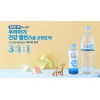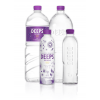|
钢化玻璃检测标准
1、目的:
对生产的安全钢化玻璃进行确认检验以验证产品满足强制认证的要求。
2、长方形平面钢化玻璃边长允许偏差应符合表1的规定。
表1 长方形平面钢化玻璃边长允许偏差 单位(mm)
|
厚度
|
边长(L)
|
|
L≤1000
|
1000<L≤2000
|
2000<L≤3000
|
L>3000
|
|
3、4、5、6
|
+1、-2
|
±3
|
±4
|
±5
|
|
8、10、12
|
+2、-3
|
|
15
|
±4
|
±4
|
|
19
|
±5
|
±5
|
±6
|
±7
|
|
玻璃公称厚度
|
对角线差允许值
|
|
边长≤2000
|
2000<边长≤3000
|
边长>3000
|
|
3、4、5、6
|
±3.0
|
±4.0
|
±5.0
|
|
8、10、12
|
±4.0
|
±5.0
|
±6.0
|
|
15、19
|
±5.0
|
±6.0
|
±7.0
|
2.1卷尺或其他长度工具测量长方形平面钢化玻璃的对角线差结果应符合表2的规定。
表2 长方形平面钢化玻璃对角线差允许值 单位(mm)
2.2厚度及其允许偏差
2.2.1使用千分尺测量,钢化玻璃的厚度的允许偏差应符合表3的规定。
表3 厚度及其允许偏差 单位(㎜)
|
公称厚度
|
厚度允许偏差
|
|
3、4、5、6
|
±0.2
|
|
8、10
|
±0.3
|
|
12
|
±0.4
|
|
15
|
±0.6
|
|
19
|
±1.0
|
|
>19
|
供需双方商定
|
2.3外观质量
钢化玻璃的外观质量应满足表4的要求。
表4 钢化玻璃的外观质量
|
缺陷名称
|
说明
|
允许缺陷数
|
|
爆边
|
每片玻璃每米边长上允许有长度不超过value="10" hasspace="False" negative="False" numbertype="1" tcsc="0" style="line-height: 1.8em; ">10mm,自玻璃边部向玻璃板表面延伸深度不超过value="2" hasspace="False" negative="False" numbertype="1" tcsc="0" style="line-height: 1.8em; ">2mm,自板面向玻璃厚度延伸深度不超过厚度1/3的爆边个数。
|
1处
|
|
划伤
|
宽度在value=".1" hasspace="False" negative="False" numbertype="1" tcsc="0" style="line-height: 1.8em; ">0.1mm 以下的轻微划伤,每平方米面积内允许存在条数。
|
长度≤value="100" hasspace="False" negative="False" numbertype="1" tcsc="0" style="line-height: 1.8em; ">100mm时;4条
|
|
宽度大于value=".1" hasspace="False" negative="False" numbertype="1" tcsc="0" style="line-height: 1.8em; ">0.1mm的划伤,每平方米面积内允许存在条数。
|
宽度value=".1" hasspace="False" negative="False" numbertype="1" tcsc="0" style="line-height: 1.8em; ">0.1mm—value="1" hasspace="False" negative="False" numbertype="1" tcsc="0" style="line-height: 1.8em; ">1mm,
长度≤value="100" hasspace="False" negative="False" numbertype="1" tcsc="0" style="line-height: 1.8em; ">100mm时;4条
|
|
夹钳印
|
夹钳印与玻璃边缘的距离≤value="20" hasspace="False" negative="False" numbertype="1" tcsc="0" style="line-height: 1.8em; ">20mm,边部变形量≤value="2" hasspace="False" negative="False" numbertype="1" tcsc="0" style="line-height: 1.8em; ">2mm
|
|
裂纹、缺角
|
不允许存在
|
2.4弯曲度
平面钢化玻璃的弯曲度,弓形时应不超过0.3%,波形时应不超过0.2%。
2.5抗冲击性
取6块钢化玻璃进行试验,试样破坏数不超过1块为合格,多于或等于3块为不合格。破坏数为2块时,再另取6块进行试验,试样必须全部不被破坏为合格。
2.6 碎片状态
取4块玻璃试样进行试验,每块试样在任何value="50" hasspace="False" negative="False" numbertype="1" tcsc="0" style="line-height: 1.8em; ">50mm×value="50" hasspace="False" negative="False" numbertype="1" tcsc="0" style="line-height: 1.8em; ">50mm区域内的最少碎片数必须满足表5的要求。且允许有少量长条形碎片,其长度不超过value="75" hasspace="False" negative="False" numbertype="1" tcsc="0" style="line-height: 1.8em; ">75mm。
表5最少允许碎片数
|
玻璃品种
|
公称厚度/mm
|
最少碎片数/片
|
|
平面钢化玻璃
|
3
|
30
|
|
4~12
|
40
|
|
≥15
|
30
|
|
曲面钢化玻璃
|
≥4
|
30
|
2.7霰弹袋冲击性能
取4块平行玻璃试样进行试验,应符合下列1)或2)中任意一条的规定.玻璃破碎时,每块试样的最大10块碎片质量的总和不得超过相当于试样65㎝2面积的质量,保留在框内的任何无贯穿裂纹的玻璃碎片的长度不能超过value="120" hasspace="False" negative="False" numbertype="1" tcsc="0" style="line-height: 1.8em; ">120mm。
弹袋下落高度为value="1200" hasspace="False" negative="False" numbertype="1" tcsc="0" style="line-height: 1.8em; ">1200mm时,试样不破坏。
2.8表面应力
钢化玻璃的表面应力不应小于90MPa。
以制品为试样,取3块试样进行试验,当全部符合规定为合格,2块试样不符合则为不合格,当2块试样符合时,再追加3块试样,如果3块全部符合规定则为合格。
2.9耐热冲击性能
钢化玻璃应耐value="200" hasspace="False" negative="False" numbertype="1" tcsc="0" style="line-height: 1.8em; ">200℃温差不破坏。
取4块试样进行试验,当4块试样全部符合规定时认为该项性能合格。当有2块以上不符合时,则认为不合格。当有1块不符合时,重新追加1块试样,如果它符合规定,则认为该项性能合格。当有2块不符合时,则重新追加4块试样,全部符合规定时则为合格。
2.10标志
包装标志应符合国家有关标准的规定,每个包装箱应标明“朝上、轻搬正放、小心破碎、防雨怕湿”等标志或字样。强制认证产品的标志检查执行《强制认证产品标志使用控制程序》
3、 试验方法
3.1 尺寸检验
尺寸用最小刻度为value="1" hasspace="False" negative="False" numbertype="1" tcsc="0" style="line-height: 1.8em; ">1mm的钢直尺或钢卷尺测量.
3.2厚度检验
使用外径干分尺或与此同等精度的器具,在距玻璃板边value="15" hasspace="False" negative="False" numbertype="1" tcsc="0" style="line-height: 1.8em; ">15mm内的四边中点测量。测量结果的算术平均值即为厚度值。并以毫米(mm)为单位修约到小数点后2位。
3.3外观检验
以制品为试样,按GB 11614方法进行。
3.4弯曲度测量
将试样在室温下放置4h以上, 测量时把试样垂直立放,并在其长边下方的1/4处垫上2块垫块。用一直尺或金属线水平紧贴制品的两边或对角线方向,用塞尺测量直线边与玻璃之间的间隙,并以弧的高度与弦的长度之比的百分率来表示弓形时的弯曲度。进行局部波形测量时,用一直尺或金属线沿平行玻璃边缘value="25" hasspace="False" negative="False" numbertype="1" tcsc="0" style="line-height: 1.8em; ">25mm方向进行测量,测量长度300mm。用塞尺测得波谷或波峰的高,并除以value="300" hasspace="False" negative="False" numbertype="1" tcsc="0" style="line-height: 1.8em; ">300mm后的百分率表示波形的弯曲度,如图6所示。
3.5抗冲击性试验
3.5.1试样为与制品同厚度、同种类的,且与制品在同一工艺条件下制造的尺寸为value="610" hasspace="False" negative="False" numbertype="1" tcsc="0" style="line-height: 1.8em; ">610mm(value="0" hasspace="False" negative="True" numbertype="1" tcsc="0" style="line-height: 1.8em; ">-0mm,+value="5" hasspace="False" negative="False" numbertype="1" tcsc="0" style="line-height: 1.8em; ">5mm)×value="610" hasspace="False" negative="False" numbertype="1" tcsc="0" style="line-height: 1.8em; ">610mm(value="0" hasspace="False" negative="True" numbertype="1" tcsc="0" style="line-height: 1.8em; ">-0mm,+value="5" hasspace="False" negative="False" numbertype="1" tcsc="0" style="line-height: 1.8em; ">5mm)的平面钢化玻璃。
3.5.2试验装置应符合GB 9962-1999 附录A的规定。使冲击面保持水平。试验曲面钢化玻璃时,需要使用相应的辅助框架支承。
3.5.3使用直径为 value="63.5" hasspace="False" negative="False" numbertype="1" tcsc="0" style="line-height: 1.8em; ">63.5mm(质量约value="1040" hasspace="False" negative="False" numbertype="1" tcsc="0" style="line-height: 1.8em; ">1040g)表面光滑的钢球放在距离试样表面 value="1000" hasspace="False" negative="False" numbertype="1" tcsc="0" style="line-height: 1.8em; ">1000mm的高度,使其自由落下。冲击点应在距试样中心 value="25" hasspace="False" negative="False" numbertype="1" tcsc="0" style="line-height: 1.8em; ">25mm的范围内。
对每块试样的冲击仅限1次,以观察其是否破坏。试验在常温下进行。
3.5.4本试验项目确认检验最低频次为每季度一组
3.6碎片状态试验
3.6.1以制品为试样
3.6.2试验设备
可保留碎片图案的任何装置。
3.6.3试验步骤
3.6.3.1将钢化玻璃试样自由平放在试验台上,并用透明胶带纸或其他方式约束玻璃周边,以防止玻璃碎片溅开。
3.6.3.2 在试样的最长边中心线上距离周边value="20" hasspace="False" negative="False" numbertype="1" tcsc="0" style="line-height: 1.8em; ">20mm左右的位置,用尖端曲率半径为value=".2" hasspace="False" negative="False" numbertype="1" tcsc="0" style="line-height: 1.8em; ">0.2mm+value=".05" hasspace="False" negative="False" numbertype="1" tcsc="0" style="line-height: 1.8em; ">0.05mm的小锤或冲头进行冲击,使试样破碎。
3.6.3.3保留碎片图案的措施应在冲击后10s后开始并且在冲击后3min内结束。
3.6.3.4 碎片计数时,应除去距离冲击点半径value="80" hasspace="False" negative="False" numbertype="1" tcsc="0" style="line-height: 1.8em; ">80mm以及距玻璃边缘或钻孔边缘value="25" hasspace="False" negative="False" numbertype="1" tcsc="0" style="line-height: 1.8em; ">25mm范围内的部分。从图案中选择碎片最大的部分,在这部分中用value="50" hasspace="False" negative="False" numbertype="1" tcsc="0" style="line-height: 1.8em; ">50mm×value="50" hasspace="False" negative="False" numbertype="1" tcsc="0" style="line-height: 1.8em; ">50mm的计数框计算框内的碎片数,每个碎片内不能有贯穿的裂纹存在,横跨计数框边缘的碎片按1/2个碎片计算。
3.6.3.5本试验项目确认检验最低频次为每班一片。
6.7 霰弹袋冲击性能试验
3.7.1 试样
试样为与制品相同厚度、且与制品在同一工艺条件下制造的尺寸为value="1930" hasspace="False" negative="False" numbertype="1" tcsc="0" style="line-height: 1.8em; ">1930mm(value="0" hasspace="False" negative="True" numbertype="1" tcsc="0" style="line-height: 1.8em; ">-0mm,+value="5" hasspace="False" negative="False" numbertype="1" tcsc="0" style="line-height: 1.8em; ">5mm)×value="864" hasspace="False" negative="False" numbertype="1" tcsc="0" style="line-height: 1.8em; ">864mm(value="0" hasspace="False" negative="True" numbertype="1" tcsc="0" style="line-height: 1.8em; ">-0mm,+value="5" hasspace="False" negative="False" numbertype="1" tcsc="0" style="line-height: 1.8em; ">5mm)的长方形平面钢化玻璃。
3.7.2 试验装置
试验装置应符合GB 9962-1999 附录B的规定。
3.7.3试验步骤
3.7.3.1 用直径 value="3" hasspace="True" negative="False" numbertype="1" tcsc="0" style="line-height: 1.8em; ">3 mm的挠性钢丝绳把冲击体吊起,使冲击体横截面最大直径部分的外周距离试样表面小于 value="13" hasspace="True" negative="False" numbertype="1" tcsc="0" style="line-height: 1.8em; ">13 mm,距离试样的中心在 value="50" hasspace="True" negative="False" numbertype="1" tcsc="0" style="line-height: 1.8em; ">50 mm以内。
3.7.3.2 使冲击体最大直径的中心位置保持在 value="300" hasspace="True" negative="False" numbertype="1" tcsc="0" style="line-height: 1.8em; ">300 mm的下落高度,自由摆动落下,冲击试样中心点附近1次。若试样没有破坏,升高至 value="750" hasspace="True" negative="False" numbertype="1" tcsc="0" style="line-height: 1.8em; ">750 mm,在同一试样的中心点附近再冲击1次。
3.7.3.3 试样仍未破坏时,再升高至 value="1200" hasspace="True" negative="False" numbertype="1" tcsc="0" style="line-height: 1.8em; ">1200 mm的高度,在同一块试样中心点附近冲击一次。
3.7.3.4 下落高度为value="300" hasspace="False" negative="False" numbertype="1" tcsc="0" style="line-height: 1.8em; ">300mm,value="750" hasspace="False" negative="False" numbertype="1" tcsc="0" style="line-height: 1.8em; ">750mm或value="1200" hasspace="False" negative="False" numbertype="1" tcsc="0" style="line-height: 1.8em; ">1200mm试样破坏时,在破坏后5min之内,从玻璃碎片中选出最大的10块,称其质量。并测量保留在框内最长的无贯穿裂纹的玻璃碎片的长度。
3.7.3.5本试验项目确认检验最低频次为每半年一组。
3.8表面应力测量
3.8.1 试样
以制品为试样,按GB/T 18144 规定的方法进行。
3.8.2 测量点的规定
如图7所示,在距长边value="100" hasspace="False" negative="False" numbertype="1" tcsc="0" style="line-height: 1.8em; ">100mm的距离上,引平行于长边的2条平行线,并与对角线相交于4点,这4点以及制品的几何中心点即为测量点。
单位(㎜)
nok="f" connecttype="rect" style="line-height: 1.8em; ">ta title="5" src="file:///C:\DOCUME~1\ADMINI~1\LOCALS~1\Temp\msohtml1\01\clip_image001.png" style="line-height: 1.8em; ">ta>
图7 测量点示意图 单位(㎜)
ta title="6" src="file:///C:\DOCUME~1\ADMINI~1\LOCALS~1\Temp\msohtml1\01\clip_image003.png" style="line-height: 1.8em; ">ta>图8 测量点示意图
若制品短边长度不足value="300" hasspace="False" negative="False" numbertype="1" tcsc="0" style="line-height: 1.8em; ">300mm时,见图8,则在距短边value="100" hasspace="False" negative="False" numbertype="1" tcsc="0" style="line-height: 1.8em; ">100mm的距离上引平行于短边的两条平行线与中心线相交于2点,这两点以及制品的几何中心点即为测量点。
不规则形状的制品,其应力测量点由供需双方商定。
3.8.3 测量结果
测量结果为各测量点的测量值的算术平均值。
3.9 耐热冲击性能
将value="300" hasspace="False" negative="False" numbertype="1" tcsc="0" style="line-height: 1.8em; ">300mm×value="300" hasspace="False" negative="False" numbertype="1" tcsc="0" style="line-height: 1.8em; ">300mm的钢化玻璃试样置于200℃±value="2" hasspace="False" negative="False" numbertype="1" tcsc="0" style="line-height: 1.8em; ">2℃的烘箱中,保温4h以上,取出后立即将试样垂直浸入value="0" hasspace="False" negative="False" numbertype="1" tcsc="0" style="line-height: 1.8em; ">0℃的冰水混合物中,应保证试样高度的1/3以上能浸入水中,5min后观察玻璃是否破坏。
玻璃表面和边部的鱼鳞状剥离不应视作破坏。
4、组批抽样方法
4.1产品的尺寸和偏差、外观质量、弯曲度按表5规定进行随机抽样。
表5 抽样表 单位(片)
|
批量范围
|
样本大小
|
合格判定数
|
不合格判定数
|
|
1~8
|
2
|
1
|
2
|
|
9~15
|
3
|
1
|
2
|
|
16~25
|
5
|
1
|
2
|
|
26~50
|
8
|
2
|
3
|
|
51~90
|
13
|
3
|
4
|
|
91~150
|
20
|
5
|
6
|
|
151~280
|
32
|
7
|
8
|
|
281~500
|
50
|
10
|
11
|
|
501~1000
|
80
|
14
|
15
|
4.2 对于产品所要求的其他技术性能,若用制品检验时,根据检测项目所要求的数量从该批产品中随机抽取;若用试样进行检验时,应采用同一工艺条件下制备的试样。当该批产品批量大于1000块时,以每1000块为1批分批抽取试样,当检验项目为非破坏性试验时可用它继续进行其他项目的检测。
5、 判定规则
若不合格品数等于或大于表8的不合格判定数,则认为该批产品外观质量、尺寸偏差、弯曲度不合格。
其他性能也应符合相应条款的规定,否则,认为该项不合格。
若上述各项中,有1项不合格,则认为该批产品不合格。
对于本公司不能实现的检验项目,有质检部委托具备国家认可的实验部门进行检验,同时国家定期的监督检验、抽检的结果可视为定期确认检验的组成部分。
认证请与我们联系
中国建筑建材检验中心第二联络处
地址:济南市天桥区成丰桥汇鑫国际商务大厦1307室
电话:0531-88889711 88889722
电子传真号码:0531-85096123-673999
隋长青经理 手机:13156172628 1555 0011888
联系人:张念15863785551
附件:钢化玻璃检测标准
|







